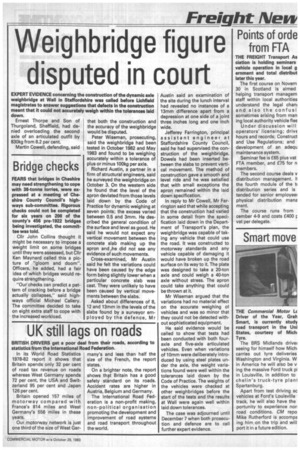Weighbridge figure disputed in court
Page 11

If you've noticed an error in this article please click here to report it so we can fix it.
EXPERT EVIDENCE concerning the construction of the dynamic axle weighbridge at Wall in Staffordshire was called before Lichfield magistrates to answer suggestions that defects in the construction meant that it could not accurately weigh within the tolerances laid down.
Ernest Thorpe and Son of Thurgoland, Sheffield, had denied overloading the second axle of an articulated outfit by 830kg from 8.2 per cent.
Martin Cowell, defending, said that both the construction and the accuracy of the weighbridge would be disputed.
Peter Wiseman, prosecuting, said the weighbridge had been tested in October 1982 and May 1983 and found to be weighing accurately within a tolerance of plus or minus100kg per axle.
Richard Austin, a partner in a firm of structural engineers, said he surveyed the weighbridge on October 3. On the western side he found that the level of the apron deviated from those levels laid down by the Code of Practice for dynamic weighing at seven points; the excess varied between 0.5 and 3mm. He described the general condition of the surface and level as good. He said he would not expect any vertical movement between the concrete slab making up the apron and he did not see any evidence of such movements.
Cross-examined, Mr Austin said he felt the variations could have been caused by the edge form being slightly lower when a particular concrete slab was cast. They were unlikely to have been caused by vertical movements between the slabs.
Asked about differences of 8, 12 and 13mm in the levels of the slabs found by a surveyor emp oyed by the defence, Mr Austin said an examination of the site during the lunch interval had revealed no instances of a 13mm difference apart from a depression at one side of a joint three inches long and one inch wide.
Jefferey Farrington, principal assistant engineer at Staffordshire County Council, said he had supervised the construction of the weighbridge. Dowels had been inserted be_tween the slabs to prevent vertical movement. The method of construction gave a smooth and level ride and he was satisfied that with small exceptions the apron remained within the laid down specification.
In reply to Mr Cowell, Mr Farrington said that while accepting that the construction had varied in some detail from the specification laid down in the Department of Transport's plan, the weighbridge was capable of taking any vehicle that could use the road. It was constructed to motorway standards and any vehicle capable of damaging it would have broken up the road surface on its way to it. The plate was designed to take a 20-ton axle and could weigh a 40-ton axle without stress. The apron could take anything that could be thrown at it.
Mr Wiseman argued that the variations had no material effect on the accurate weighing at vehicles and was so minor that they could not be detected without sophisticated equipment.
He said evidence would be called to show that tests had been conducted with both fouraxle and five-axle articulated vehicles. Even when variations of lOmm were deliberately introduced by using steel plates under the axle, the weight variations found were well within the tolerances laid down by the Code of Practice. The weights of the vehicles were checked at other weighbridges before the start of the tests and the results at Wall were again well within laid down tolerances.
The case was adjourned until December 7 when both prosecution and defence are to call further expert evidence.




























































































